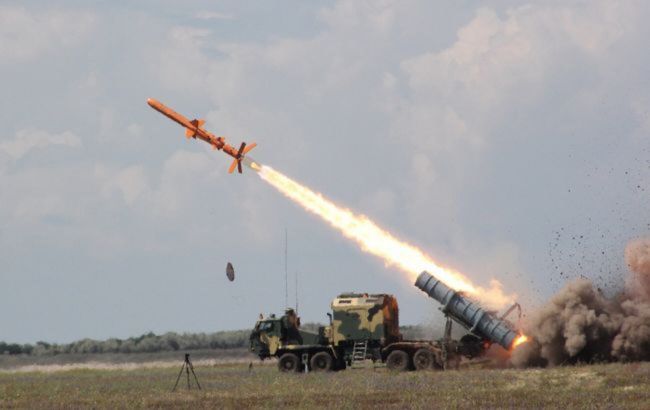Range up to 1,000 km: specifications of new long-range Neptune missile revealed
 Illustrative photo: coastal missile system RK-360MC Neptune with R-360 missile (facebook.com/GeneralStaff.ua)
Illustrative photo: coastal missile system RK-360MC Neptune with R-360 missile (facebook.com/GeneralStaff.ua)
The upgraded land-attack version of the Neptune missile can fly three times farther than the original anti-ship variant and carries a warhead that is 110 kilograms heavier, according to Defence Express.
The outlet recalled that the new missile’s appearance was first showcased only during the Independence Day exhibition in 2025.
It has now revealed the maximum range and warhead weight of this modified version.

Screenshot from video
Increased warhead and flight range
The upgraded system has been designated Neptune D, while the modernized missile carries the index RK-360L.
The declared flight range of the new version reaches 1,000 kilometers, which is 3.5 times greater than that of the original anti-ship R-360 variant with a range of 280 kilometers.
The warhead weight of the RK-360L has increased to 260 kilograms, compared to 150 kilograms in the anti-ship version. This growth is unusual, as extended range typically comes at the cost of a lighter payload.
In the Neptune D system, engineers managed to increase both range and warhead mass simultaneously, a notable achievement that suggests the missile’s design allows for adjustable configurations. Depending on mission requirements, the balance between fuel capacity and warhead weight can be altered, sacrificing fuel volume for higher destructive power if needed.

RK-360L
According to previously released photos, the RK-360L missile measures approximately 6 meters in length without the booster, making it about 1.5 meters longer than the earlier version. The body diameter has also increased to around 50 centimeters, compared to 38 centimeters previously.
Another key feature is its versatility, the missile is designed to strike both land and maritime targets, meaning it retains the capability to engage moving objects.
Although the exact details of the guidance system have not been disclosed, the indication of its ability to target ships suggests that the active radar homing head from the original Neptune design has likely been preserved.
@ukroboronprom showed the main technical characteristics of the Ukrainian cruise missile "Neptune D":
— Cloooud (@GloOouD) October 1, 2025
Warhead — 260kg
Operational range — up to 1000km
Purpose — to strike sea and land targets
These missiles recently hit the "Electrodetal" plant in the Bryansk region pic.twitter.com/qCCbZbVhwa
'
Adaptation for land-based flights
To enable the Long Neptune to operate over land, engineers had to overcome a series of complex technical challenges.
First, the missile was equipped to take off and fly over variable terrain, which is far more difficult than maintaining stable flight over flat sea surfaces.
Second, it was designed to navigate along a predetermined route without relying on satellite guidance, ensuring operational capability even in GPS-denied environments.
Third, it can now accurately strike land-based targets, a far more complex task than homing in on a large metallic ship against the uniform background of the sea.
Additionally, the RK-360L simultaneously achieves both extended range and increased warhead weight, showcasing a major leap in design efficiency.
Neptune cruise missile
The R-360 Neptune is a Ukrainian anti-ship cruise missile developed by the Kyiv-based Luch Design Bureau between 2010 and 2020.
It was originally designed to destroy naval vessels with a displacement of up to 5,000 tons and carried a 150 kg warhead. Its initial range reached up to 300 km. The missile flies at subsonic speed (around 900 km/h) and at ultra-low altitudes, just a few meters above sea level, while maintaining maneuverability throughout its trajectory.
Starting in 2023, the design was adapted for land-attack missions: the warhead was increased to 350 kg, and the range extended first to 400 km, and later to 1,000 km.
Launch capability was envisioned from three platforms: ship-based, land-based, and air-launched.
In 2019, a land-based variant, the RK-360MC system, was produced, consisting of several vehicles including a command post, launcher, and transport-loading vehicle.
In 2020, the Neptune coastal missile system with R-360 missiles was officially adopted by the Armed Forces of Ukraine.
Combat use of Neptune missile
The Long Neptune (RK-360L) was first shown in a video released on Ukraine’s official defense portal Zbroya during the Independence Day celebrations.
In March, President Volodymyr Zelenskyy announced the successful test of the Long Neptune missile, which demonstrated a flight range of up to 1,000 kilometers.
Most recently, on the night of September 29, Ukrainian Neptune missiles struck the Karachev Electrodetal plant in Russia’s Bryansk region, a facility producing components for the Russian defense industry.

